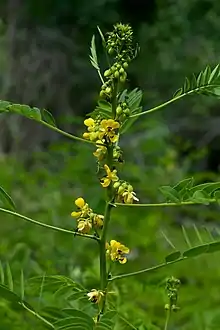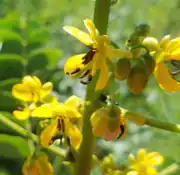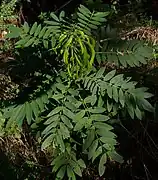Senna marilandica
Senna marilandica, commonly known as Maryland senna,[3] Maryland wild senna,[4] and wild senna,[5] is a perennial flowering plant in the pea family (Fabaceae) native to the United States. It blooms in the summer with yellow flowers, followed by long seed pods, and can grow up to 2 m (6 ft) tall. It prefers average to wet soil.
| Senna marilandica | |
|---|---|
 | |
| Scientific classification | |
| Kingdom: | Plantae |
| Clade: | Tracheophytes |
| Clade: | Angiosperms |
| Clade: | Eudicots |
| Clade: | Rosids |
| Order: | Fabales |
| Family: | Fabaceae |
| Subfamily: | Caesalpinioideae |
| Genus: | Senna |
| Species: | S. marilandica |
| Binomial name | |
| Senna marilandica (L.) Link (1831, as "marylandica") | |
| Synonyms[2] | |
|
Synonyms
| |
Description
Senna marilandica has green, round, unbranched stems rising from a shallow, fibrous root system, reaching a height of about 2 m (6 ft). The compound leaves are alternate and pinnate with four to eight pairs of opposite leaflets on each leaf. Leaflets are up to 6 cm (2.5 in) long and 2 cm (0.75 in) wide and are ovate to elliptic in shape.[5]
The inflorescences are racemes of six to nine yellow flowers, appearing both from the leaf axils (axillary) and at the end of the stems (terminal). The axillary inflorescences are up to 15 cm (6 in) long, and the terminal inflorescence is about 15–30 cm (6–12 in) long. Each flower is about 2 cm (0.75 in) across, with five yellow petals and five greenish yellow sepals. The stamens have prominent brownish anthers. The flowers do not have nectaries.[6][7] After the flowers are fertilized, drooping pea-like seed pods, up to 8 cm (3 in) long, appear.[5]
Distribution and habitat
S. marilandica is native in the United States from Nebraska to the west, Florida and Texas to the south, Wisconsin to the north, and New York to the east.[8] It is a species of special concern in Wisconsin.[9] The plant is found in woodland edges, open fields, and thickets, and in moist areas such as riverbanks and moist prairies.[6][10]
Ecology
The flowers bloom from early July through late August, and the seed pods form from early August through late September.[9] Bumblebees, butterflies, and solitary bees visit the flowers. Although the flowers do not have nectaries, extrafloral nectaries are located at the base of the leaves that are higher on the stem, in the inflorescence, and ants, parasitic wasps, and lady beetles feed on the nectar.[5][11]
S. marilandica is a larval host to the cloudless sulphur (Phoebis sennae), orange-barred sulphur (Phoebis philea), sleepy orange (Eurema nicippe), and little sulphur (Eurema lisa) butterflies.[12][13]

_along_the_Cacapon_River.jpg.webp) Senna marilandica on the banks of the Cacapon River
Senna marilandica on the banks of the Cacapon River Seed pods of Maryland senna
Seed pods of Maryland senna
References
- "NatureServe Explorer 2.0". explorer.natureserve.org.
- "Senna marilandica (L.) Link". Plants of the World Online. Royal Botanic Gardens, Kew. Retrieved 29 December 2019.
- USDA, NRCS (n.d.). "Senna marilandica". The PLANTS Database (plants.usda.gov). Greensboro, North Carolina: National Plant Data Team. Retrieved 10 November 2015.
- "Senna marilandica (Maryland Senna, Maryland Wild Senna) | North Carolina Extension Gardener Plant Toolbox". plants.ces.ncsu.edu.
- "Know Your Natives – Wild Senna". Arkansas Native Plant Society. 2 September 2015.
- "Maryland Senna (Senna marilandica)". www.illinoiswildflowers.info.
- "Senna marilandica page". www.missouriplants.com.
- "Senna marilandica". County-level distribution map from the North American Plant Atlas (NAPA). Biota of North America Program (BONAP). 2019.
- "Maryland Senna (Senna marilandica) - Wisconsin DNR". dnr.wi.gov.
- Denison, Edgar (2017). Missouri Wildflowers (Sixth ed.). Conservation Commission of the State of Missouri. p. 155. ISBN 978-1-887247-59-7.
- "Plants for Pollinators: Wild Senna". Xerces Society.
- The Xerces Society (2016), Gardening for Butterflies: How You Can Attract and Protect Beautiful, Beneficial Insects, Timber Press.
- "HOSTS - The Hostplants and Caterpillars Database at the Natural History Museum". www.nhm.ac.uk.
